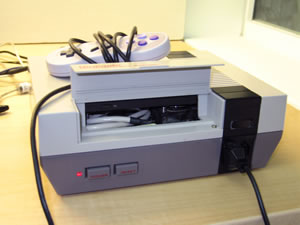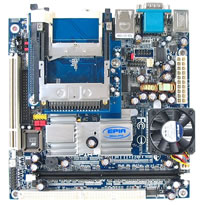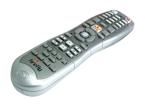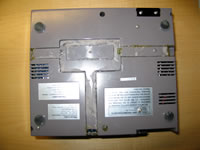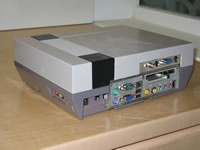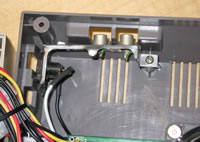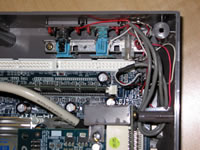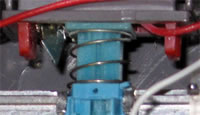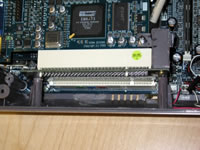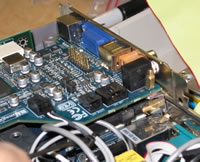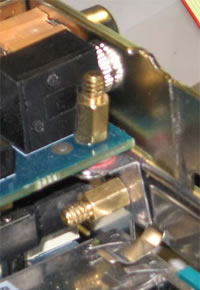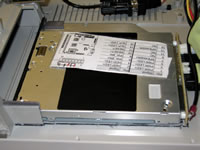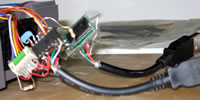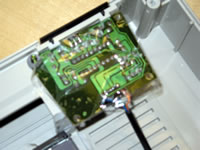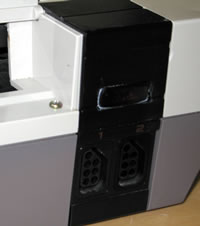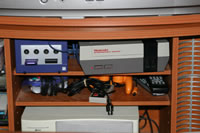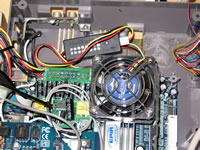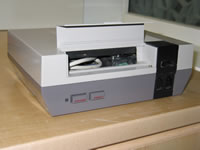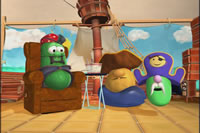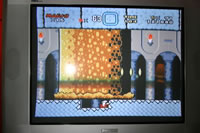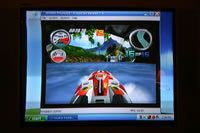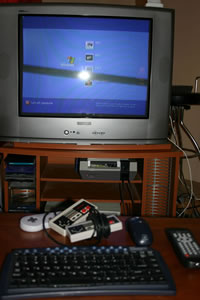» Projects & hobbies » Nintendo PC DIY
Since writing this (2004), the Nintendo PC has seen a lot of changes. It now has Intel Core 2 Duo technology and is a fairly beefy machine. It has been further carved up with dual gigabit nics and is used as a Windows Domain for a church office - perfect for their closet shelf! But it still plays a mean Super Mario Bros!(TM)
Abstract
Remember the Nintendo NES craze of the 80ís? The SNES? Surely youíve played the Nintendo 64 right? Likely your NES died long ago, but who says you canít play those games on your computer? There are several emulators out there for each and every Nintendo and Sega platform, and if you have the software ROMs for those games, then you can play those games on a PC. But without the right controller, itís just not the same gameplay. So Iím going to show you how hook up a Nintendo pad to a PC.
Media Center PCís are the newest craze too, but most all of them are huge, noisy, and ugly. Or theyíre crazy expensive. What you really want is a media center PC that is quiet, cool, capable and affordable.
At some point a couple coworkers in my office asked me to spec parts for a media center PC for them. I did what they wanted Ė and they came out big, powerful, ugly and expensive. In the process I concluded that what I wanted was something small, unique, silent, and classic. Hence the Nintendo PC. Iím not the first guy to do this, and to give credit, this is an earlier one. But from what I can tell that person didnít set up the Nintendo controller ports, make it capable of being a media PC, etc. So Iím going to show you how to build a retro Nintendo PC Media Center console! Your friends will think you have mad case mod skills, and your Gamecube-playiní kids Ė if you have any Ė will wonder what that thing is that youíve made, and your coworkers will likely want to borrow the coolest Sneaker PC in the office.
Click any picture to enlarge.
Parts List
Thereís not much room for err here so Iím going to be pretty specific about the parts, and what to consider when making your purchases.
Motherboard Decisions
$200 - $650
First youíre going to need a mini-ITX format motherboard. These little guys are only 170mm on each side, but they can come feature-packed. Generally speaking, mini-ITX boards are overpriced because they are a niche product. Make sure it has an onboard USB pinout connector in addition to the USB connectors on the connector panel Ė you can use this to rig up your Nintendo controller ports!
VIAís EPIA models are good because they are somewhat quiet (or silent), produce little heat and are feature-packed. Unfortunately theyíre not very fast either. If you are going to go with VIA I would suggest the SP13000 or the MII12000. The 12000 is a 1.2 GHz processor with a lame video adaptor. The SP13000 has a 1.3 GHz processor but has a slightly less lame video adaptor. The good news is that both models do have an onboard MPEG decoder so your processor isnít spent doing that. They both have 5.1 Channel surround sound, with digital coax output, and one PCI slot, 1394, USB 2.0, and so on. Some have CF and PCMCIA card slots as well. These will set you back $200-$250, plus an additional $50 for a power supply daughter card that takes a 12v power brick supply (also a separate purchase) and outputs the ATX power connection.
If money is no object for you, you might consider the new Pentium M mini-ITX boards. The LV-673 from Commell is amazing really Ė giving you all the capabilities of a new high-end laptop, except for 1394. This is a much higher-performance option, especially when it comes to the onboard video adaptor and the processorís number-crunching ability. That also equates to more heat, which you will have to deal with. Oh, and while this thing has a PCI-express x16 slot, it doesnít have 1394. If I had this project to do over again, I would go this route. Alas, these new motherboards were not available when I built the Nintendo PC.
Which should you get? If money is no object, go for the Pentium M setup. It will cost you about $400 for mobo, no processor, fan, and no memory. $150 to $250 for the processor.
Nintendo Console
$0-$35
$0 Ė if you have one in your attic.
$25-$35 on ebay Ė try to get a console with a couple of authentic controllers.
It doesnít need to work. You will be ripping out the electronics.
Nintendo controllers
$0-$20
These can be had for as little as $5 on ebay. Donít get the aftermarket compatible models, for crying out loud. Youíre building a sweet retro Nintendo! Get an original (or two). Get a Super Nintendo Controller if you want to play Super Nintendo games, and Iíll show you how to hook that up to the original NES controller port later.
Video Capture and Display
$200-$400
Oh, we said this would be a Media PC, didnít we? Well the hardware you get will matter a LOT. Do your homework and research a model that will fit your requirements. It needs to be short and low profile - i.e. no video cards with huge cooling fans this time. In fact most video cards are going to be too long.
What I decided to do was get the RealMagic X-card. This cool $99 PCI card is very similar to the DVD decoder cards of old in that it takes the output of the VGA and routes it back into a decoder card via a supplied VGA adaptor. Then it does an analog hardware overlay to place a high-quality (up to 780p) output across the VGA, RGB, S-Video or composite outputs. It will handle DVDís, DiVX, and other MPEG-1/2/4 formats. But note that it only handles decoding and not encoding! I didnít realize that when I got it, so that was a surprise, but it decodes at a significantly better video quality than the onboard chip, and again the CPU is not tied up. The software is pretty poor, but thatís okay because you donít have to rely on it. It has a remote, and fits nicely inside the Nintendo as you will see.
So, now what about encoding? How are you going to record things? Again, time to do your homework. You must make sure that your encoder is truly a hardware encoder which does the work itself rather than passing on the work to the CPU (which your little Nintendo just wonít be able to do well). I settled on the $200 Plextor ConvertX PX-TV402U-NA PVR. The NA stands for North America Ė in other words, NTSC only! This device will encode and then relay pretty much any type of MPEG-1/2/4 stream, including certified DiVX! It is an external device that pushes its stream via USB 2.0. Even though itís doing the work, I found you still need a decent computer to keep up with displaying the stream, and my VIA MII12000 was completely maxed out recording and displaying a DVD-quality input. But it works well, has good software, and can use TitanTV to schedule recordings. Note that it doesnít come with antennae nor remote.
With both of these products, all I can say is make sure you get the most recent drivers and software! The originals are horrible.
Keyboard/Mouse/Remote Control
$0-$120
Keyboards and mice are quite personal things. You will probably want something wireless. If you decide to use Windows XP Media Center Edition, you will probably want to get a compatible (pricey) remote for it. In truth these decisions are closely tied to what applications and operating system you go with. There is no need to get Windows Media Center, provided that you have the software to do what you want. BeyondTV is an option, and there are others. Maybe the encoding and decoding hardware you settle on will have all you need. I actually had an old gyration keyboard and mouse combo lying around, so I use that. It has great range, and you can use the mouse in the air pointing it like a gun and moving your wrist. Gyration also has a media center version where the mouse and remote control are integrated together that looks decent.
DVD/CD-ROM drive
$140-$180
You need a laptop-sized, slot-loading slim combo drive. $150 will get you a black, slot loading, dual-layer multi-format drive known as the Pioneer DVR-K04L. Itís quite an amazing device.
Hard drive
$0-$175
Not that you need me to explain this to you, but decide on a laptop-sized 2.5Ē model that balances size, price, and performance. These laptop drives are a performance bottleneck when it comes to loading programs, and if this bothers you go for a 5400 or even 7200 RPM drive. If you get a motherboard that supports SATA, then you should consider a drive that supports this, as the cabling is cleaner. Also, since this is a media PC, bigger means more space for movies or recordings. But since you bought a motherboard with 1394 (you did, didnít you?) you can easily hook up that old external firewire hard drive of yours for more movie space. If you donít have 1394, donít fret, you can obtain a USB 2.0 enclosure for any normal 3.5Ē IDE hard drive for a small price. So in the end the size of this hard drive might not matter much to you. If you have a busted laptop, then perhaps you can use its hard drive.
Memory
$40
Get at least 512 MB.
PCI Riser Card
$12
If you use a PCI card, you will need this. Get this one: it is an angle extension that is just the right height and direction to go directly above the motherboard and will fit below the DVD drive once assembled.
Nintendo USB Controller Chips
2 x $17
You can find these at retrozone for $17 each. You can buy the Nintendo NES chip or the SNES RetroKit. I found that itís actually the same part for both, just wired differently.
Processor Fan
$0-$10
For noise reasons, you might want to replace the one that came packaged with your CPU/motherboard. Get a rheostat as well, so that you can control the fan speed with a simple dial. This is the secret to a quiet machine. The Nintendo shell has really bad ventilation, so you might consider replacing your VIA 40mm CPU fan with a 60mm quiet fan. It will just fit.
Game ROMs
Donít even ask, youíre on your own here. Nintendo says itís illegal to own software ROMs if you donít have the same original cartridge games. Seems pretty questionable to me, if I own the cartridge.
Power Brick
$50
Something like a 12 volt 100 Watt power brick should suit you. If you want you can go larger, but thereís not much point.
Cables
$15
- One ribbon cable IDE
- One shorty rounded-cable IDE
IDE Adaptors
$16
- One Slimline DVD drive to IDE adaptor like this model.
- One notebook hard drive to IDE adaptor like this model.
Tools and Miscellaneous parts
$16
- Dremel tool with cutting wheel and small drill bit
- Shoe Goo
- Superglue
- Double-sided tape
- Tin snips
- Clear packing tape
- Leftover screws and studs from other case and motherboard products
- Thin Sharpie-type permanent marker
- Needle-nosed pliers
- Screwdrivers
- A little spare wire
- Pointed picture frame backing studs
- CD-ROM audio out connectors (2)
Case Moddiní
Start by dismantling the old Nintendo console. Donít throw anything away just yet, as we will reuse a lot of parts! Take it completely apart, but save the screws. As you can see, this is going to be a very tight fit, especially if you are planning on using the PCI slot. Just warning ya.
Look at the dark grey base. There are a bunch of little plastic columns where the screws come thru to hold the unit together. Take out your motherboard and observe that it will just fit on the left side (if the unit is facing you) if you knock out a lot of those columns. Take your dremel tool to cut them off at their base Ė and keep them for later. Try to make the inside fairly flush. The only columns you will still have left are the two on each angled side of the base, and the one in the center-front underneath the cartridge bay. Thatís still plenty to hold the unit together. And donít forget to cut out the corresponding columns in the top of the case if you cut them at the bottom Ė should just be the one at the center-back. Oh, and if you plan on re-using the original Nintendo power and RCA ports Ė which will make it look more authentic Ė then you should not cut off the mounting column on the right side for that little AV connector box.
If you are going to use the PCI slot, then you need to cut out the T-Shaped elevated area in the bottom as well. This is difficult to do neatly, but just try your best. Cut it so that you can glue it back inside the bottom of the case flush with everything else. You will need to trim it a few times to get the fit right. Then take some packing tape and tape the gaps on the bottom side. You will now basically mold a casting to hold the T-shaped portion to the rest of the case. From the inside of the case, take the superglue and put a drop on the places where the pieces touch. After that has dried, take the Shoe Goo and carefully fill the gaps. Epoxy also works well if it is good epoxy and you get the mixture right. I was in the Middle East when I tried this, and the epoxy there is horrible Ė never would dry well, and when the unit was hot it would run out of the cracks!
Now itís time to fit the motherboard. You want to mount it as low as possible, to the left back corner of the case. To mount the motherboard you will have to create sockets for the mounting holes of the motherboard in the case. Using the Sharpie/marker, mark where the holes will be for the screws. Take the face plate for the back of the motherboard and mark where you will need to cut a hole in the case for it. Use the dremel with the cutting tool to cut the rectangular hole in the back side of the case, starting with just the bottom half. You may find it easier to cut straight lines by stacking books or something underneath the dremel so that you are just moving it across. Becareful here Ė you can always cut more if you donít cut enough, but if you cut too much, that is permanent! After you have done the bottom half, mark the outline for the upper half of the case and cut enough to get the back case plate to just fit with the unit assembled.
Now to deal with the motherboard mounting screws. They have to be mounted from the bottom side, thru both the case and the motherboard. Also, there is about a 2 mm gap between the motherboard and the case. To fill this gap, take the columns you cut out earlier and slice eight 2 mm washers out of them. You will need to widen the holes of four of them, and the other four will serve as the nuts to hold the motherboard on. At this point you can go ahead and attach the motherboard. You will probably need to use needle-nosed pliers to get your plastic nuts snug Ė but not too snug.
For extra cool points, try to re-use the original Nintendo AV and power ports. You will need to carefully take it off the Nintendo breadboard and tear it apart. This is where some powerful tin snips come in handy. You only want the 2 sides of the metal box that have the connectors. Cut everything else off except but leave the hole for screwing it back in at the side, and take care not to bend it up too much. I was able to reuse the power connector with my power brick, but had to cut everything off past the channel selector switch to make room for the motherboard. I thought about reusing the audio and video RCA connectors for video out and coax audio out, but these will no doubt have a lot of noise on them and the motherboard I chose already had these connections. So I just left them unconnected.
Power and Rest Buttons
The blue or white (or both) push switches are simply to large to fit with the motherboard there because they will get in the way of the IDE cables. This might not be the case with the Pentium M mini-ITX. Also, the power switch keeps the signal low (connected) once you press it because of itís designed to stay depressed. Donít worry, this is very fixable. If you cut off the large back end of the switches (everything past the springs) then you have something that fits, and doesnít stay depressed. Note that you will have to leave enough plastic there to keep the spring from sliding off. You still need the spring-action! Now everything will fit and the power button will return to normal open position when you release it, therefore allowing the motherboard to power on correctly.
Well, except that itís not wired! Whops! Donít worry; this one is fixable as well. Take a piece of wire that is thin and long enough to get from the pinout for the hard drive led, power and reset buttons area on the motherboard to the power buttons, with extra for error. Perhaps the best thing to do is get a CD-ROM audio cable because these will adapt to the motherboard pins perfectly. The ground wires you will ground to the metal bar that the buttons are attached to. Each positive/signal wire will be wrapped around a bent and pointed picture frame backing joint set inside of the buttons with a bit of superglue so that when the button is pressed the metal tip of the picture frame joint touches the metal bar the switches are attached to. This will complete a circuit when depressed.
Now you can test your hardware. Attach the CPU and memory, power, etc and just turn it on. Make sure that your buttons and LED work as expected.
At this point, go do something else, hang out with friends or something. It no doubt took a while to get this far and youíre in danger of becoming a hermit. You have the main portion of the case mod done. But there are still a lot of details we will have to address to finish this up.
PCI Riser
If you are using a PCI or PCI-Express riser card, you will want to create some mounting brackets for it so that it stays in place! I found that just inserting things and screwing the PCI card face plate to the back of the unit wasnít enough to keep the riser and card in place Ė the rocky desert roads of Qatar caused them to come lose. It took me a while to realize that the PCI card was lose and not hosed! If you bought the riser card I mentioned above then you got one with mounting holes.
The way to do this is to stick the PCI riser in the PCI slot, then take two plastic columns that you cut out of the bottom of the Nintendo case and cut them to just fit between the side of the case and the riser card. You will screw the riser card to the side of the case using these columns, so make sure you use two columns that you havenít torn up to make washers and nuts to hold the motherboard in place. Also, these columns will probably contact the side of the case along the edge where the angled side meets the straight side, so you will have to cut the other end to fit. Get it right, so that the riser card will have the right angle. Attach the columns to the side of the case with Shoe Goo.
PCI Card
You will have to cut the top of the Nintendo case so that your PCI card face plate is exposed. I beat the face plate flat so that the angle where the screw usually goes was flat. That end of the face plate will set on and in front of the motherboard face plate (see picture) so that they help to keep each other in place. If you got the X-Card or if your PCI card has holes in it for mounting, then you will also be able to fasten the card in better to prevent it from coming loose. Using tin snips, cut out a small chunk of sheet metal from the leftover Nintendo console parts about 1 cm x 2 cm. Shape it into an L bracket with rounded edges, and punch two holes for screws using your dremel.
If you bought the VIA MII1200 then, oddly enough, there is a hole in the motherboard
face plate directly underneath the hole in the X-Card behind the PCI face plate
Ė how convenient! Using appropriate screws and those brass motherboard mounting
screws that come with computer cases, secure your PCI card to the face plate of
the motherboard.
Again, if you bought the parts I did, you can also fasten the back of the PCI card to the riser card. You can stack flat pieces of plastic to create another L-bracket like the one in the picture here and punch holes in it to keep the back of the PCI card in the riser slot. You can create the plastic strips from the cover that was on the bottom of the case in the center of the elevated T-shaped section you cut out and made flat.
DVD drive
I hope you waited until now to do attach the drive. If you didnít, then you chanced cutting into the drive when you made the hole for the PCI slot! It is barely too wide to fit as is to the underside of the top of the case so you will need to cut off one of the plastic game cartridge guides Ė cut off the one on the right. Use the double-sided tape without exposing the sticky side to the DVD drive to test the fit of the Drive. Go ahead and attach the pin adaptor and ribbon IDE cable because those factor into the fit Ė it will be tight. You may need 2 or more layers of tape, not just one. Once you are happy with the fit, remove the plastic from the tape and make it a permanent fit. Cut a couple strips from leftover plastic and superglue them to the case alongside the DVD and then under the DVD on each side to keep the DVD drive in place when/if the tape starts to fail under heat.
Hard Drive
As you can see, thereís not a whole lot of space left in the case, except for on the right side Ė and thatís where the hard drive will go. You will place it on itís side over the air slits in the bottom of the case. To secure the hard drive you have a couple options. One is to take some double-sided tape and cover the 9.5 mm side you will put down with a 3 cm-wide strip of tape. Then you mash it down into the case, and take two 2 cm-wide strips on each side overlapping the first piece of tape on the hard drive with the excess width being applied to the bottom of the case to keep it stationary. While this might be a good shock absorber, it cuts back on the circulation and cooling efficiency of the case and hard drive.
Your other option is to make a couple plastic ďLĒ brackets and screw the drive into the plastic brackets which are super glued into the bottom of the case. You might want to hold of on that until you have seen how other cables will fit.
IDE cables Ė you will probably be best off with a short 8 or 10 inch rounded cable, stuffed underneath the cartridge bay.
Nintendo Controller Ports
Now for a little more case mod fun. Pull out those USB-to-Nintendo controller chips you picked up from Retrozone. Yes, they were in fact a bit overpriced, but heís got a corner on the market. If you got the old version it will have several resistors and other components that you have the joy of wiring first. If he forgot to include the URL to the wiring diagram (or the diagram itself) then email and he will get it to you. If he tells you to check the website FAQ, tell him itís still not there, and he will give you the correct URL. I am going to describe how to wire these things on the inside of the Nintendo rather than inside the game pads. If you fancy tearing up an authentic game pad, then wire up the chip inside the game pad, but you arenít going to be able to use the Nintendo ports on the case.
On the Nintendo circuit board, the controller ports connect via a small 7-conductor beige connector. I would pull out your soldering gun and remove them in order to use them for convenience Ė if you have the old style USB chip, Shoe Goo them to the back side of the chip. If you have the new style, you will probably just want to leave them separate. Wire the chips as the diagram shows you. The USB cable included only needs to be a couple inches, so chop that back before you connect it. Now you need to get the USB connector into the motherboard. If your motherboard was complete, it probably came with the necessary adaptor. If not, you will need to get one. You can find an internal front bay connector for USB 2.0 like this one and then use the pertinent guts from that.
To fit all this in the case, take the clear plastic tape and put a layer on the chips so that they donít somehow short each other. Then you can stuff them down into the front right corner of the case around the plastic column. Run the USB cables underneath the cartridge bay where the IDE cables are. Coil the excess cable between the motherboard and the PCI card or between the PCI card and the DVD drive.
SNES Game Pads
If you have a SNES controller, you can actually hook this up to the NES controller ports, and use the same chips! This way you can use a SNES controller for those SNES games. I really wish I had my diagrams to show you, but I have packed everything up and am in the process of moving. The secret is to take another Nintendo controller plug (from the light zapper if you have it) and carefully disconnect the plug from the wires. Now wire the SNES controller wires into the NES controller plug with the same color combinations and sequence you find on the female side of the ports in the case. Now compare the diagrams that Retrozone supplies for wiring the SNES and NES pads to the chips they supply. If you notice, they are the same except for two wires that are reversed on the SNES diagram. So take those two wires that differ and swap their locations in the NES plug. Now your chip will be able to communicate with both controller types. You will probably have to reconfigure the joystick properties in Windows so that the buttons do the right thing if you switch from NES to SNES controller.
Infrared
So if you bought a fancy remote, or you are using the X-Card, you will have an infrared receiver. Why put this ugly thing on top of the Nintendo when it can fit inside! What you need to do is dismantle it as much as possible. It will probably come down to a small circuit board with a couple of LEDís on the front of it. The best place to mount this is above the Nintendo ports in the case. If you are using the X-Card, the circuit board is pretty wide Ė the quickest approach is to fasten it to the case with a screw just inside the cartridge bay thru one of the holes in the circuit board (see picture) and use a plastic nut created from those cut-off columns. If you are really concerned about this screw throwing off your authentic look of the case then you could create another plastic ďLĒ bracket and fasten it from the other side if you are so inclined. But that is much more difficult, and youíve just cut a big hole in the case for your infrared receiver anyway!
Cool Quietly
If you are using a VIA MII1200 or similar model, no doubt you have noticed by now that the fan isnít very quiet. How fun would it be to watch a movie with the whine of the CPU fan? You would no doubt get used to it, but I would recommend swapping it with a 60mm fan. I used the Stealthô model, because it was supposed to be quiet. It is a snug fit up against the memory and the ATX power supply daughter board, and I secured it with some clear packing tape. I found that in practice it really wasnít much quieter after all. But it pushes plenty of air. So I picked up a rheostat and put that inline the CPU fan connector. Now I can really make this thing silent, and push just enough air to keep it from melting down when the Nintendo is sitting on a table in a cool room. When in a cabinet with poor circulation, you wonít be able to run silently.
For Pentium-M folks, you might also want to try the rheostat trick. Iím not sure how hot it will run in the crammed case, but it will give you opportunity to run it quietly.
Other Bits
There are other things you may want to wire to complete things Ė which are specific to your combination of motherboard, PCI-Card, and so on. I went ahead and wired an extra ground wire between the power supply daughter board and the DVD drive adaptor because I had noise on the audio output of the drive. I also soldered a cable from the motherboard coax digital output connector to the input connector on the X-Card.
Testing & Configuration
There's a lot that can go wrong in this project, so make sure you test things thoroughly.
Smoke Test
Did you wire it right? Nowís the time to find out! Double check the polarity for the power and reset buttons, any grounding wiring you added, coax connections, etc. Turn it on and watch for smoke. If it looks good, boot into Windows and test your infrared wiring. Test the Nintendo USB chips.
Fit and Finish
Does everything look like it will fit in the case? Check that once you close the case, nothing exposed can possibly come into contact and short each other out. Go ahead and close it up, and call it finished.
Media Center Features
Since this is all software-driven, Iím not going to get much into testing and sorting that out. It can be a chore in itself. I can tell you that I am able to record DVD-quality video for play now or later, but I donít think I have been able to record in DiVX format yet. Plextor released new drivers that I will need to test, that issue is hopefully fixed. I am able to play beautiful DVDís with very vibrant color up to 780p High Definition. I can watch TV if I have one hooked up, and record that too. All without using any of the features of Windows XP Media Center Edition!
Emulating Nintendo Games
To play the games, you need the ROMs and the emulators. Youíre on your own for getting the ROMs. The emulators are freely available at http://www.emulator-zone.com For playing N64 games I found that the 1964 Emulator and the Project64 Emulator worked best, depending on which game you were considering. One is faster while the other is more compatible. My system is barely able to keep up with some of the games, and GoldenEye is way too intensive for the integrated graphics and N64 emulation. For the SNES emulation I found ZNES to work well. For NES, VirtuaNES works well. NES and SNES emulators are plenty fast but seem to have a jiggyness to them Ė I think this is a refresh rate issue (the Nintendos ran at 50 Hz whereas the PC runs at 60 Hz). You might not see that issue if you use the TV output.
If you create a separate user account for each system, and set the respective emulator to start automatically at logon, then even a five-year-old can turn on the Nintendo, click the user (with a picture of the appropriate Icon) and play the games.
Conclusion
Wow, for a cool $500-$700 we built a stinkiní cool and expensive Nintendo and at the same time incorporated Media PC functionality. If I had it to do over again, I think I would go for the Pentium M setup for a little more horsepower. Itís a shame that PCI video cards cannot be crammed into this little box! I canít justify the expense of doing that now.
